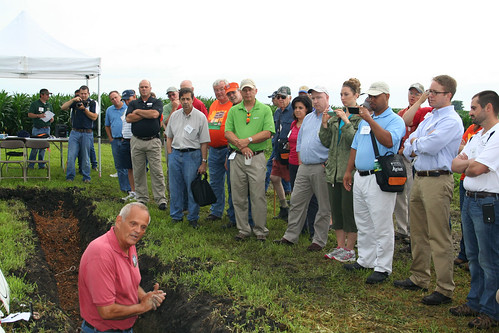
A recent tour in Livingston, Ill. showcased the successes a powerful partnership has had in the Indian Creek Watershed.
The 6th Annual Conservation in Action Tour was organized by the Conservation Technology Information Center to highlight community efforts in the watershed taking place under the auspices of the USDA Natural Resources Conservation Service’s Mississippi River Basin Healthy Watershed Initiative.
Through the initiative, the Natural Resources Conservation Service (NRCS) and partners work with landowners and farmers to address nutrient loading in priority small watersheds within the Mississippi River Basin. Program participants implement voluntary conservation practices that improve water quality, restore wetlands and enhance wildlife habitat while allowing them to sustain or improve agricultural productivity. Illinois is one of the 13 states included in the initiative.
More than 270 people from 20 states attended the all-day July tour, including NRCS Chief Jason Weller. Tour attendees visited three farms to listen to local producers and researchers talk about water quality issues being addressed in the watershed. Those attending were federal and state employees, agribusiness representatives and producers.
Producer panels answered questions about their experiences with conservation. They explained the conservation practices they use, such as cover crops, rotational grazing and manure management, and their associated benefits, including increased production, improved soil quality and water quality protection. A live demonstration on aerial seeding of cover crops and a dragline for applying nutrients added to the presentations.

More than 40 percent of the farmers in the Indian Creek Watershed currently participate in NRCS’s Conservation Stewardship Program. CSP is a voluntary conservation program that encourages producers to address resource concerns in a comprehensive manner, including enhancements that specifically improve water quality.
“We have a lot of family-owned farms,” Eric McTaggart, NRCS District Conservationist in Livingston County, said, “and it’s nice to be able to work hand-in-hand with them to ensure that [preservation for future generations] takes place.”
Terry Bachtold, whose farm was the first tour stop and who is resource coordinator for the Livingston County Soil and Water Conservation District, said the initiative can inspire change beyond its participants.
“A lot of farmers are seeing what one farmer does,” he said, “and they are going to try those same practices on their own land. It is a community effort.”
Follow NRCS on Twitter.
Check out other conservation-related stories on the USDA blog.




